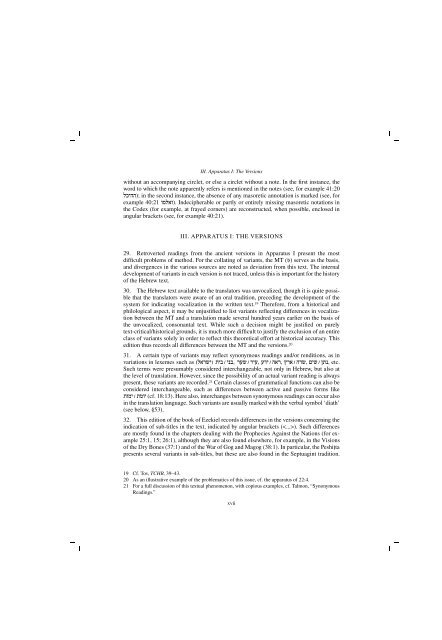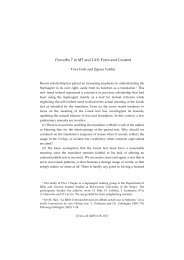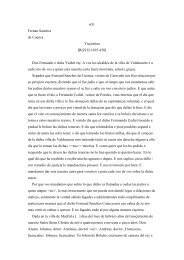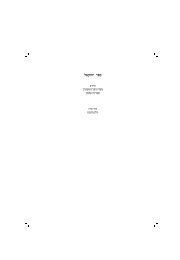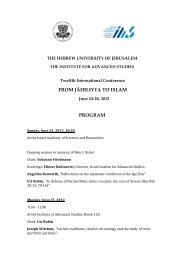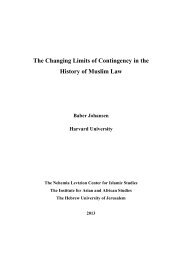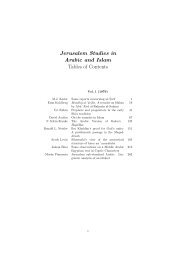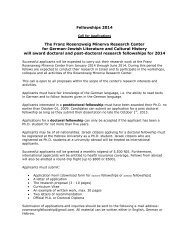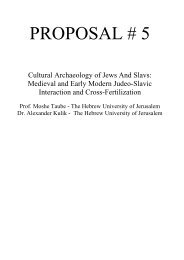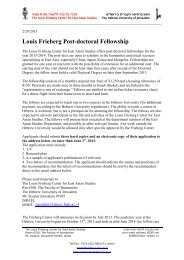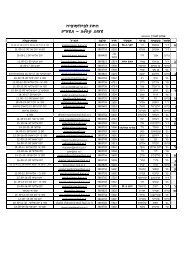THE BOOK OF EZEKIEL Moshe H. Goshen-Gottstein Shemaryahu ...
THE BOOK OF EZEKIEL Moshe H. Goshen-Gottstein Shemaryahu ...
THE BOOK OF EZEKIEL Moshe H. Goshen-Gottstein Shemaryahu ...
You also want an ePaper? Increase the reach of your titles
YUMPU automatically turns print PDFs into web optimized ePapers that Google loves.
III. Apparatus I: The Versions<br />
without an accompanying circlet, or else a circlet without a note. In the first instance, the<br />
word to which the note apparently refers is mentioned in the notes (see, for example 41:20<br />
lkidd); in the second instance, the absence of any masoretic annotation is marked (see, for<br />
example 40:21 enl`e). Indecipherable or partly or entirely missing masoretic notations in<br />
the Codex (for example, at frayed corners) are reconstructed, when possible, enclosed in<br />
angular brackets (see, for example 40:21).<br />
III. APPARATUS I: <strong>THE</strong> VERSIONS<br />
29. Retroverted readings from the ancient versions in Apparatus I present the most<br />
difficult problems of method. For the collating of variants, the MT (x) serves as the basis,<br />
and divergences in the various sources are noted as deviation from this text. The internal<br />
development of variants in each version is not traced, unless this is important for the history<br />
of the Hebrew text.<br />
30. The Hebrew text available to the translators was unvocalized, though it is quite possible<br />
that the translators were aware of an oral tradition, preceding the development of the<br />
system for indicating vocalization in the written text. 19 Therefore, from a historical and<br />
philological aspect, it may be unjustified to list variants reflecting differences in vocalization<br />
between the MT and a translation made several hundred years earlier on the basis of<br />
the unvocalized, consonantal text. While such a decision might be justified on purely<br />
text-critical/historical grounds, it is much more difficult to justify the exclusion of an entire<br />
class of variants solely in order to reflect this theoretical effort at historical accuracy. This<br />
edition thus records all differences between the MT and the versions. 20<br />
31. A certain type of variants may reflect synonymous readings and/or renditions, as in<br />
variations in lexemes such as (l`xyi) zia / ipa, xry / xir, rci / d`x, ux` / dcy, miy / ozp, etc.<br />
Such terms were presumably considered interchangeable, not only in Hebrew, but also at<br />
the level of translation. However, since the possibility of an actual variant reading is always<br />
present, these variants are recorded. 21 Certain classes of grammatical functions can also be<br />
considered interchangeable, such as differences between active and passive forms like<br />
zeni / znei (cf. 18:13). Here also, interchanges between synonymous readings can occur also<br />
in the translation language. Such variants are usually marked with the verbal symbol ‘diath’<br />
(see below, §53).<br />
32. This edition of the book of Ezekiel records differences in the versions concerning the<br />
indication of sub-titles in the text, indicated by angular brackets (). Such differences<br />
are mostly found in the chapters dealing with the Prophecies Against the Nations (for example<br />
25:1, 15; 26:1), although they are also found elsewhere, for example, in the Visions<br />
of the Dry Bones (37:1) and of the War of Gog and Magog (38:1). In particular, the Peshitta .<br />
presents several variants in sub-titles, but these are also found in the Septuagint tradition.<br />
19 Cf. Tov, TCHB, 39–43.<br />
20 As an illustrative example of the problematics of this issue, cf. the apparatus of 22:4.<br />
21 For a full discussion of this textual phenomenon, with copious examples, cf. Talmon, “Synonymous<br />
Readings.”<br />
xvii


